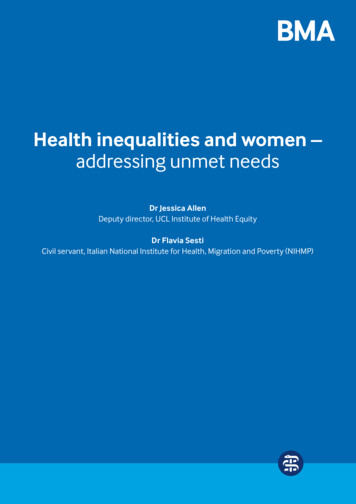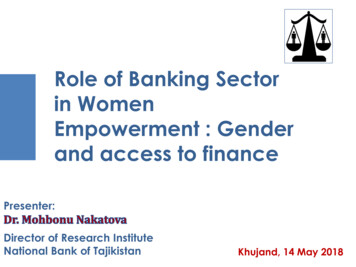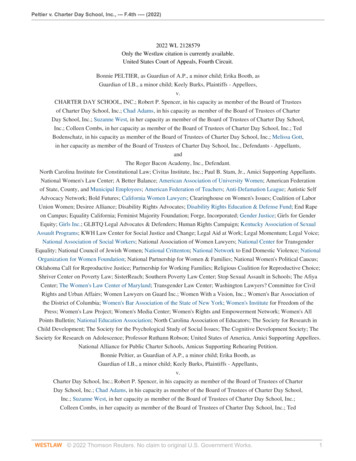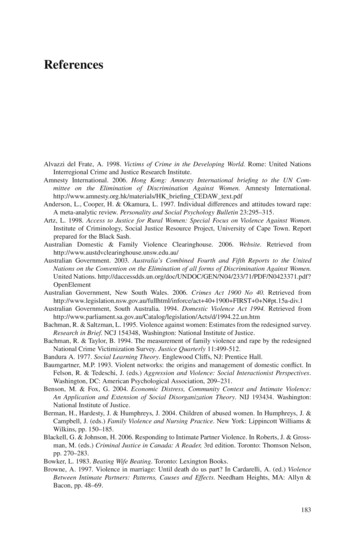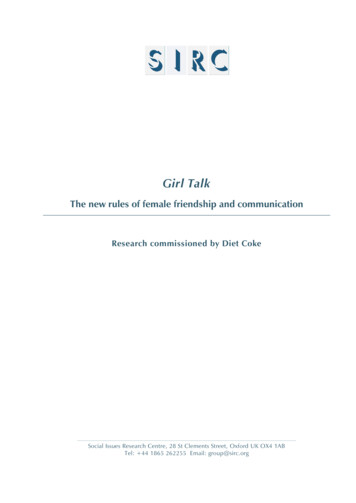
Transcription
SERIESPAPERDISCUSSIONIZA DP No. 6551Family Planning and Women’s and Children’s Health:Long Term Consequences of an Outreach Programin Matlab, BangladeshShareen JoshiT. Paul SchultzMay 2012Forschungsinstitutzur Zukunft der ArbeitInstitute for the Studyof Labor
Family Planning and Women’s andChildren’s Health: Long TermConsequences of an Outreach Programin Matlab, BangladeshShareen JoshiGeorgetown UniversityT. Paul SchultzYale Universityand IZADiscussion Paper No. 6551May 2012IZAP.O. Box 724053072 BonnGermanyPhone: 49-228-3894-0Fax: 49-228-3894-180E-mail: iza@iza.orgAny opinions expressed here are those of the author(s) and not those of IZA. Research published inthis series may include views on policy, but the institute itself takes no institutional policy positions.The Institute for the Study of Labor (IZA) in Bonn is a local and virtual international research centerand a place of communication between science, politics and business. IZA is an independent nonprofitorganization supported by Deutsche Post Foundation. The center is associated with the University ofBonn and offers a stimulating research environment through its international network, workshops andconferences, data service, project support, research visits and doctoral program. IZA engages in (i)original and internationally competitive research in all fields of labor economics, (ii) development ofpolicy concepts, and (iii) dissemination of research results and concepts to the interested public.IZA Discussion Papers often represent preliminary work and are circulated to encourage discussion.Citation of such a paper should account for its provisional character. A revised version may beavailable directly from the author.
IZA Discussion Paper No. 6551May 2012ABSTRACTFamily Planning and Women’s and Children’s Health: Long TermConsequences of an Outreach Program in Matlab, Bangladesh*The paper analyzes the impact of an experimental maternal and child health and familyplanning program that was implemented in Matlab, Bangladesh in 1977. Village data from1974, 1982 and 1996 suggest that program villages experienced extra declines in fertility ofabout 17%. Household data from 1996 confirm that this decline in “surviving fertility”persisted for nearly two decades. Women in program villages also experienced otherbenefits: lower child mortality, improved health status, and greater use of preventive healthinputs. Some benefits also diffused beyond the boundaries of the program villages intoneighboring comparison villages. These program effects are robust to the inclusion ofindividual, household, and community characteristics. This paper concludes that the benefitsof this reproductive and child health program in rural Bangladesh have many dimensionsextending well beyond fertility reduction, which do not appear to dissipate after two decades.JEL Classification:Keywords:O12, J13, I12, J16fertility, family planning, health and development, program evaluation,BangladeshCorresponding author:T. Paul SchultzDepartment of EconomicsYale UniversityBox 208269New Haven, CT 06520-8269USAE-mail: paul.schultz@yale.edu*This paper is forthcoming in Demography. A longer version is available as an Economic GrowthCenter Discussion Paper no. 951, Yale University. The research was funded by the MacArthurFoundation. T. Paul Schultz was also supported in part by a grant from the Hewlett Foundation.Comments are appreciated from participants at various workshops and conferences at which earlierversions of this paper were presented, as well as from Kenneth Land and three anonymous referees.The programming assistance of Paul McGuire has been valuable. Errors and omissions are our own.
1. IntroductionThis paper estimates the impact of a reproductive health intervention in Matlab, Bangladesh onbroad measures of well-being of women and their families. The Maternal and Child Health and FamilyPlanning (MCH-FP) program, launched in 1977, provided married women in designated “treatment”villages with home delivery of contraceptive supplies, follow-up services, and general advice (Phillipset al. 1982). Additional maternal and child health services were added over time (Phillips et al. 1988,Fauveau 1994; Muhuri, 1995). Women in neighboring “comparison” villages were served mainly byclinics run by the Bangladesh government.Women in both areas were tracked carefully andcontinuously. The Matlab experiment has been shown to have significantly reduced fertility as well asmaternal, infant and child mortality (Phillips et al. 1982, 1988; Koenig et al. 1990, 1991; Fauveau,1994; Rahman et al. 2009).This paper uses Census data from 1974 and 1982 together with the Matlab Health andSocioeconomic Survey (MHSS) of 1996 to make three contributions. First, new methods confirm thattreatment and comparison areas in Matlab had similar pre-program characteristics, a fact that has beenimplicitly assumed in much of the Matlab literature but rarely demonstrated. This increases confidencein the quasi-random design of this intervention (e.g. Bertrand, Duflo, and Mullinathan 2004; Duflo,Glennerster and Kremer 2008). Second, unlike most existing studies which have focused on the initialdemographic impacts of the program, particularly between 1976 and 1985, this paper illustrates thatthe program had long-term impacts on not only fertility but also child mortality and maternal and childhealth more broadly. Third, this paper illustrates that the program may have had informational“spillovers” that lowered fertility in comparison area villages that lie adjacent to the treatment villages.This has implications for estimating impact and cost-effectiveness of the program. Overall, the resultssuggest that policies along the lines of the Matlab experiment may be effective not only in loweringfertility, but also in improving the long-term health of mothers and their children. Traditional costbenefit calculations of such policies tend to neglect such multifaceted effects.This paper also contributes to the broader literature on the effectiveness of family planning andreproductive health programs (Schultz, 2008). Some research now corroborates the assertion that suchprograms reduce fertility and have cross effects on variables such as infant mortality or femaleemployment. Most studies however, are based on cross-sectional or panel data, and face the challengeof omitted variables and/or non-random program placement: if programs are placed in areas with2
different demands for children and health, estimates of impact may be biased and lead to spuriousestimates (Rosenzweig and Wolpin, 1982; Schultz, 1994). The Matlab experiment’s quasi-randomdesign permits researchers to compare individuals who did and did not have the opportunity to benefitfrom the program and to make stronger causal inferences. The finding that its effects persisted overnearly two decades, and had numerous “spillovers” is thus noteworthy.The remainder of this paper is structured as follows: Section 2 briefly reviews the literature onMatlab; section 3 contrasts village outcomes from 1974 to 1996; section 4 presents regression analysisat the individual level; section 5 summarizes relevant studies of program costs and benefits; andsection 6 concludes.2. BackgroundMatlab thana (sub-district) lies about 55 kilometers south of Dhaka, Bangladesh’s capital. It is a flatand low-lying deltaic plain. The region is entirely rural and has limited inter-village trade andcommerce. The dominant occupations are subsistence farming and fishing. The society is quitetraditional and religiously conservative, particularly with regards to the status of women (Abdullahand Zeidenstein, 1979; Chen et al. 1983; Menken and Phillips 1990; Fauveau 1994). The total fertilityrate has declined from more than 6 to 3.2 between 1976 and 1995 (Fauveau 1994; ICDDR,B 2004).Infant mortality has fallen from 110 per thousand live births in 1983, to 75 in 1989 and 65 in 1995.In 1966, the International Center for Diarrhoeal Disease Research, Bangladesh (ICDDR,B)established a Demographic Surveillance System (DSS) to record monthly births, deaths, marriages,migration within 149 villages. In October 1977 it launched a maternal and child health and familyplanning program. Villages in contiguous areas (blocks A, B, C, and D) including about half of the180,000 population of Matlab received the services of a family planning outreach program (hereafterreferred to as “program”), while the remainder (blocks E and F) continued to receive only usual healthand family planning services delivered through local government clinics or private providers (hereafter“comparison”).The program recruited relatively educated and married women from the surrounding area whopracticed contraception themselves to provide home delivery of health services to married women of3
childbearing age every two weeks. These Community Health Workers (CHWs) advise women on theuse of birth control, provide supplies (including the pill and injectable) as well as follow-up services,and refer women to local clinics or hospital when necessary (Phillips et al. 1982, 1988). After 1981additional maternal and child health services were added to the program, such as tetanus toxoidimmunization for women, measles immunization for children 9 months to 5 years, and then other EPIchildhood vaccinations, oral rehydration therapy (ORT) for diarrhea, vitamin A supplements, andantenatal care, etc. (Phillips et al. 1988; Fauveau 1994). By the 1990s, the Government of Bangladeshprovided some of these vaccinations but their adoption is not recorded (LeGrand and Phillip 1996,p.58.1An influential literature in public health and demography has examined these reliable and detailedregistration data interpreting observational regularities and experimental programs in Matlab. Whilethe literature is too large to review comprehensively, a few important studies are noted which arerelated to our results. An early study showed that the prevalence of modern methods of contraceptionamong married women of reproductive ages increased sharply from 7% to 33% after 18 months ofprogram operation, which was sustained for two years and then continued to increase after 1982(Phillips, 1988; Koenig et al. 1992). DSS quarterly general fertility rates from 1976 to 1981 showedthat the program areas experienced 22 to 25% lower fertility than did the comparison areas (Phillips, etal. 1982). From 1978 onwards neonatal mortality rates were slightly lower in treatment thancomparison areas, but the subsequent declines in these rates do not appear to differ (Fauveau, 1994:p.144). The impact of measles vaccination in the treatment areas on child mortality is documented, andcontributed to the adoption of this preventive health intervention by the Bangladesh GovernmentHealth program and elsewhere (Koenig et al. 1990, 1991; Menken and Phillips, 1990; LeGrand andPhillips, 1996). But the persistence of these early CMH-FP intervention effects on long term familyoutcomes of fertility and maternal and child health are rarely assessed. Several other studies arediscussed in subsequent sections of this paper.This paper extends this literature by analyzing the impact of the program using the 1996 MHSS.1Measles declined more rapidly in the entire MCH-FP program areas than in the comparison areas, although perinatalmortality did not decline in the early period of 1979-82 (Koenig et al. 1990; Fauveau et al. 1990; LeGrand and Phillips1996). Maternal mortality in treatment villages may have declined more rapidly though it is difficult to estimate precisely(Koenig et al. 1988; Fauveau 1994; Rahman et al. 2009).4
This is a multistage cluster random sample of approximately one-third (2687) of the baris (residentialcompounds typically of linked kin) in the Matlab DSS, covering 4364 households (Rahman et al,1999).2 One household in each bari is randomly selected, and one additional household is purposelyselected to favor close kin. Married women are selected if they are the head, the spouse of the head, orif they or their spouses are older than 50. A second person is selectively chosen. The survey isdesigned to be representative when these two strata of women are suitably weighted to account for thelesser representation in the sample of people living in baris with many households, or households withmany women age 15 to 49.3 Our sample includes married women because they were eligible for theCMH-FP treatment. In the group of women aged 15--24, 25—29 and 30—54, the proportion ofwomen who are ever-married is, 41% , 89%, and 99% respectively.3. Unconditional Estimates of Program ImpactThe first step of our analysis is to compare fertility of married women between the program andcomparison areas using the 1996 MHSS.4 We regress total fertility (children ever born) on agedummies as well as their interaction with residence in a program village. Figure 1 plots the resultingexpected values of fertility for women by age groups in the treatment and comparison areas. The lowerpanel shows the difference between the treatment and comparison fertility coefficients and their 95%2The MHSS is a collaborative effort distributed by the Inter-University Consortium for Political and Social Research(ICPSR) at the University of Michigan and Rand (rand.org/labor/FLS/MHSS/html).3We use sample weights that correspond to an individual’s probability of selection from Matlab into the MHSS. They arefrom the Rand public use data file called MHDWGTS (variable name is pr ind12) and are intended to adjust observationsfor within-household selection as well as the selection of the household. We cap very low probabilities of selection at 0.1.All values below this are recoded as 0.1, as suggested by the MHSS codebook (page 34). Our sample of 5307 omits 34women for whom sample weights could not be found in the public release data file, and community infrastructure datacould not be matched to one village. Differences between program and comparison individuals and estimates of reducedform relationships with predetermined control variables discussed in the paper are weighted to be representative. Unweighted regressions were also estimated, and are available from the authors. See further discussion of weights in footnote5.4An important caveat here is that the original resident population in 1977 may not be represented in the 1996 MHSS.Female migration and mortality could change the composition of the population observed in 1996 in treatment and controlvillages. When dummy variables are added to the fertility or other outcome regressions that are equal to one only if thewoman moved after marriage into the DSS area, or moved from program to comparison areas, or vice versa, thesedummies are never statistically significant as explanatory variables in the fertility or family outcomes studied here.5
confidence interval (i.e. 1.96*standard errors). Fertility among married women over the age of 55 in1996 is indistinguishable between the program and comparison villages, consistent with the hypothesisthat these older women had virtually completed their childbearing when the program began and these“pre-program” fertility levels did not differ in the treatment and comparison areas. Conversely, theunconditional fertility of younger women in the program villages is lower than in comparison areas.This corroborates the persistence of early evidence by Phillips et al. (1982, 1988) and others who findby 1979 that post-program general fertility rates were 25% lower in the program than comparisonvillages.A second way to assess the program effect on fertility between the program and comparisonvillages is to analyze changes over time in aggregate measures of fertility at the village level.Weperform this comparison using census data from 1974 and 1982. Because the number of children everborn to a woman is not reported, we use age and sex of residents to construct the ratio of the numberof children aged 0 to 4 to the number of women of childbearing age 15 to 49 (C/W) as an aggregatemeasure of “surviving fertility” in the last five years. Aggregate “difference in difference” estimates ofthe program’s effect can be derived from a regression across the 141 villages constructed from theCensus of 1974 before the program, and either the 1982 Census or the weighted 1996 MHSS:C/Wjt β0 β 1 Pj β 2 Tt β 3 Pj*Tt ejtj 1, 2, ., 141, for villages ; and t 1974 and 1982 or 1996 ,where C/Wjt is the child-woman ratio in village j in time period t, Pj takes value 1 if village j is in theprogram program area and zero otherwise, Tt takes value 1 if the observation is for a year after theprogram has started (i.e. 1982, 1996) and zero for the pre-program year 1974, Pj*Tt is the interactionof the two variables, and ejt is the error. The pre-program fertility differences between program andcomparison villages is estimated by β1, change over time in all areas is estimated by β2, and the postprogram treatment effect on those residing in a program village in a subsequent census or survey isestimated by β3.Because the impact of the program is assumed homogeneous in all villages,including village-level fixed effects would yield the same estimates of the program effect.OLS estimates of the above equation generate the local average program’s treatment effect6
(LATE) after the program started in 1977 or β3, holding constant for any pre-existing persistentdifferences in fertility between the treatment and comparison villages as measured in 1974 that arerepresented by β1. Because the variance in the observations on village surviving fertility, ejt, areexpected to be heteroskedastic and greater for smaller villages, the regressions are therefore estimatedusing generalized least squares (GLS) where the weights (i.e. STATA aweights) are the inverse of thesquare root of the number of women age 15-49 observed in each village observation. The sample sizeis 282 from combining two cross sections of villages, and the GLS estimates are reported in the twocolumns of Table 1 for the two different post-program census or survey years, 1982 and 1996.The values of the child-woman ratio for the treatment villages are on average slightly largerthan in the comparison villages , β1 .022 (Table 1, col. 1). Five years after the launch of the programin 1982, the C/W is, holding constant the initial village levels in 1974, 17% lower in the program thancomparison villages, β3 -.143, namely -.14/.81 -.17 . In 1996 this difference in differenceestimator of the program effect (Table 1 column 2) is -.127 or 16% lower than in 1974, despite the factthat this child-woman ratio declined in the comparison villages by 39% by 1996 (β2/β0 or -.31/.81 -.39). This difference in child-woman ratios is one approximation for the program’s impact onindividual “surviving family size”, or community natural rates of population growth.The 1974 Census also provided indicators of education, housing, and religion. Populationweighted differences between the averages for program and comparison villages are summarized inthe last two columns of Table 2.5 Note that there was no statistically significant difference in levels offormal schooling in the two areas for adults over the age of 14 and children aged 6-14 in 1974.However, Muslims are more dominant in 1974 in the comparison than in the program areas, 88 vs.79%, which is statistically significant between the groups of village means, i.e. t 2.01. This religiousdifference also increases over time, and by 1996 (Table 2, panel (B)) it is 93 and 80% in the two areas,respectively. Because Muslims engage in different occupations than the minority Hindus, and theirlivelihoods might affect their desired family size and economic behavior, a control for Muslim religion5Many individuals in the 1996 MHSS in the two representative strata 1 and 2 cannot be matched to a weight in the Randdata file: roughly one fourth of the adults 15 , and somewhat larger share of the children aged 6-14. To see if thecharacteristics of those matched to a weight differed, the un-weighted individuals were assigned the average weight in thematched sample, which was .53. The population means for the villages in the program and comparison areas did notchange appreciably, and the differences were very similar to those reported in Table 2 Panel B.7
of the household head is included in the subsequent multivariate analysis of the 1996 MHSS.Moreover, the program average treatment effects are allowed to differ for Muslim and Hinduhouseholds, to assess possible heterogeneity in their response to the program (Fauveau 1994; Munshiand Myaux 2006).Between 1974 and 1996, years of schooling of adults roughly doubled in Matlab (Table 2). In1996 they are greater in program than comparison areas (3.73 versus 3.60 years, but the difference isnot significant. The village average years of schooling of children age 6 to 14 are also significantlyhigher in the program villages by 1996, 2.26 vs. 1.84 years, consistent with the hypothesis that parentswith program assistance in controlling their fertility traded off child quantity for child quality (e.g.Becker and Lewis 1974).4. Conditional Estimates of Program ImpactAssuming that the program and comparison areas had similar characteristics in 1977, the partialassociations of the program in 1996 with long-term outcomes are estimated at the individual level, firstas the treatment-comparison differences unconditional on any control variables (Table 3), and thenconditional on a common set of arguably predetermined control variables. The dependent variables areas follows:1) Fertility/child mortality (Tables 4 and 5): (i) The number of children ever born; (ii)Number of children alive; (iii) Age (in years) at which a woman had her first birth; (iv) Years betweenthe birth of the first and second child ; (v) Years between the birth of the second and the third child ;(vi) A binary variable that takes value 1 if the child died before the age of five, and 0 otherwise.2) Women’s health (Table 6): (i) A subjective measure of current health (CurrHealthy) thattakes the value of 1 if a woman’s self-assessment of her health status is "Healthy" and 0 otherwise; (ii)The self-reported capacity to perform five activities of daily living (ADLs) that is normalized to 1 (nofunctional limitations) or60 (maximum limitations)(ADLEq0);.6(iii) the woman’s weight inADLEq0 (1.0-ADLscore). A woman’s self-reported capability to perform five activities of daily living, drawn fromsection GH2 of the MHSS, are aggregated into a score: (a) walk for one mile; (b) carry a heavy load for 20 meters; (c)draw a pail of water from a tube-well; (d) stand up from a sitting position without help; (e) use a ladder to climb to a8
kilograms ; (iv) A woman’s body-mass-index in kg/m2 (BMI) ; (v) A binary variable that takes value1 if a woman’s BMI is greater than 18, and 0 otherwise.3) Use of preventive health inputs (Table 7): (i) The average number of antenatal visits perpregnancy for all of a woman’s pregnancies; (ii-iv) A binary variable that takes value 1 if the mostrecent child born in the past 5 years received a vaccination against polio, measles and DPT .We examine woman resides in a program area. The program’s impacts are however expectedto vary by the woman’s birth cohort or age in 1996. As already noted, the program effect should benegligible among women over the age of 60 in 1996, unless there are intergenerational spilloverswithin the household or bari. But the program effect may not increase monotonically among youngerwomen who had more years at risk of childbearing after the program started but fewer years to bearchildren and is allowed to vary by women’s five-year age groups.A second independent variable is whether a woman resides in a comparison-area village thatshares a common boundary with a program village. The program’s impact in these communities canprovide insights into the mechanisms of behavioral change. For example, if the program’s maincontribution was to reduce the costs of using contraceptives and health-care services, we can expectwomen in boundary areas to remain largely unaffected by the program’s presence and show outcomessimilar to other comparison area villages. If however, the program’s main contribution was to changesocial norms and provide new information about improved health technologies, we should see thesewomen in boundary villages resemble their counterparts in program villages. In this case, we couldinfer that knowledge may have diffused geographically through social networks and influencedbehavior in neighborhoods where women shared their knowledge and experiences (Munshi andMyaux 2006). Understanding such spillover effects is important for two additional reasons: First,positive (negative) spillovers can lead to an understatement (overstatement) of the program’s effectsestimated only by local average treatment effects (LATE). Second, if spillovers are small relative toprogram direct effects, such evidence of weak diffusion could help to justify the continuing costlyprogram component of the fortnightly visits to each woman’s home. The strength of social networksmay also differ by the age of the women, suggesting an additional reason to allow the spillover effectstorage place that is at least 5 feet in height. Responses were coded either as “can perform the task easily” (a value of 1),“can do it with difficulty” (2) and “unable to perform” (3). This ADL index is normalized following Stewart et al. (1990).9
to differ by three age groups for women. We assume the effect of the Matlab MCH-FP program in“boundary” comparison villages is a constant share of the direct program effect, if it shares at least oneboundary with a treatment village, and is otherwise negligible.7Because the behavior of women living in a village on the boundary of the program may differfrom women in other comparison villages and differ by the woman's age, auxiliary regressions wereestimated only for women in comparison areas. To conserve space, we only summarize the resultshere. These unconditional differences between boundary and non-boundary villages measure programlocal spillovers. We find that the 12 percent of the comparison women in boundary villages had 0.35(t 2.55) fewer births in 1996, whereas the proportion of their children born before 1991 who haddied by age 5 is surprisingly larger, namely .022 (1.86)). Women’s health indicators are mixed: betterfor weight, BMI, BMI greater than 18, and ADLs, whereas fewer women report themselves ascurrently healthy in the boundary villages. The receipt of childhood vaccinations for polio and DPTare significantly less common in the boundary than in the other comparison villages, whereas thefrequency of measles shots and antenatal care of the women does not differ. These simple geographicdifferences with no controls suggest that fertility changes may have partially diffused from theprogram villages without the benefit of supplies and services delivered in the home, but this beneficialspillover was not evident for indicators of child or maternal health, or the use of preventive healthinputs.Since women’s reproductive behaviors may be influenced by additional variables that are notthemselves attributable to family choices, and could differ across treatment and comparison areas, wealso include a variety of control variables. Female years of schooling is included to control for thehigher opportunity costs of the time of more educated women to have an additional child that may bepartially offset by their higher income opportunities (Mincer 1963; Schultz 1981, 2002) and schoolingmay improve their skills to evaluate health inputs or contraceptives. Female schooling is also7The functional form that the diffusion of health knowledge follows is not established in the empirical literature.Alternative specifications of this spillover effect were explored, but none we tried provided a better fit to the data onchildren ever born, child mortality to age five, etc. Miguel and Kremer (2004) model the health externalities of intestinalworms in a school age cohort in terms of the logarithm of the number of treated persons in the geographic area. Why thisspecification is adopted is not discussed, though it does provides a basis to decompose the effects of the interventionoperating through population density, and the density of treatment in the program area.10
interacted with the program (Treatment X YrsSch) to assess the possibility that a woman’s schoolingand access to the treatment are substitutes in the use of effective new forms of birth control. Someprevious studies of family planning in Colombia in 1964, Taiwan in the late 1960s, and Thailand in thelate 1970s (Schultz 1980, 1992) found that both schooling and local family-planning programs areassociated with lower levels of fertility, but their interaction is partially associated with higher fertility.Muhuri (1995) also reports that the MCH-FP program is associated with a larger decline in childmortality among the less-schooled women.As explained previously, we include a dummy if the household head is Muslim, and interactthis with the treatment area dummy (Treatment X Muslim). If family planning knowledge is less likelyto be shared informally between Muslims and Hindus than within these groups, the minority Hindusmight be at a disadvantage in social learning processes, and thus have more to gain from the program’soutreach informational efforts (Munshi and Myaux 2006).We also include a variety of controls for husband characteristics, household composition andvillage infrastructure. A control is included for the husband’s schooling as a measure of householdincome/wealth that is fixed at the start of the adult life cycle, and is not expected to reduce fertility asmuch as the wife’s education (Schultz 1981). Husband’s age is also included in quadratic form as anindicator of household life cycle income and wealth, and a dummy is set to one if t
Georgetown University T. Paul Schultz Yale University and IZA Discussion Paper No. 6551 May 2012 IZA . the program had long-term impacts on not only fertility but also child mortality and maternal and child . Matlab thana (sub-district) lies about 55 kilometers south of Dhaka, Bangladesh's capital. It is a flat and low-lying deltaic plain.

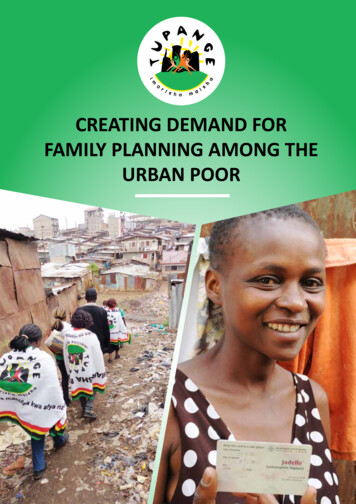
![Malawi 2015-16 Demographic and Health Survey - Key Findings [SR237]](/img/37/sr237.jpg)
